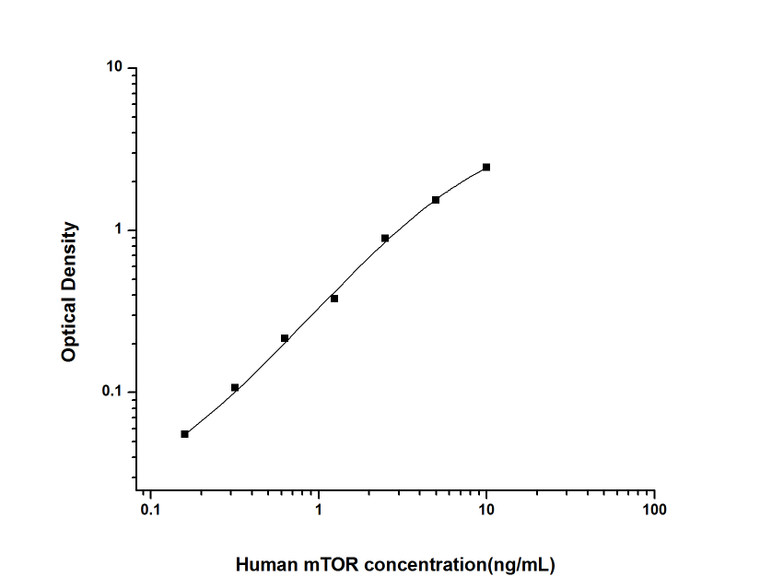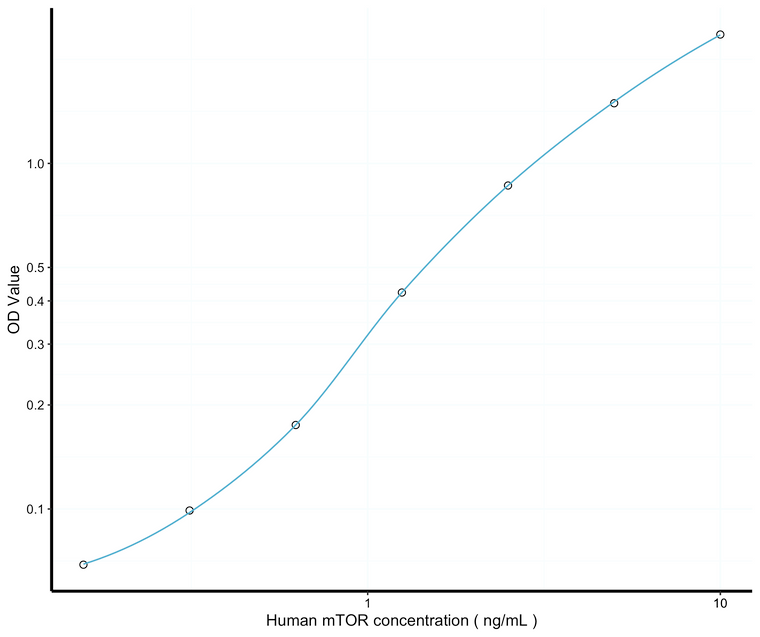| Applications: | ELISA |
| Reactivity: | Human |
| Note: | FOR SCIENTIFIC EDUCATIONAL RESEARCH USE ONLY (RUO). MUST NOT BE USED IN DIAGNOSTIC OR OTHER MEDICAL APPLICATIONS. |
| Sensitivity: | 0.09ng/mL |
| Detection Limit: | 0.16~10ng/mL |
| Short Description: | This MTOR Sandwich ELISA is an in-vitro enzyme-linked immunosorbent assay for the measurement of samples in human serum, plasma and other biological fluids. |
| Storage Instruction: | If unopened the kit may be stored at 2-8°C for up to 1 month. If the kit will not be used within 1 month, store the components separately, according to the component table in the manual. |
| Assay Time: | 3.5h |
| Detection: | Colormetric |
| Gene Symbol: | MTOR |
| Gene ID: | 2475 |
| Uniprot ID: | MTOR_HUMAN |
| Specificity: | This kit recognizes Human mTOR in samples. No significant cross-reactivity or interference between Human mTOR and analogues was observed. |
| Sample Type: | Serum, plasma and other biological fluids |
| Post Translational Modifications | Autophosphorylates when part of mTORC1 or mTORC2. Phosphorylation at Ser-1261, Ser-2159 and Thr-2164 promotes autophosphorylation. Phosphorylation in the kinase domain modulates the interactions of MTOR with RPTOR and AKT1S1/PRAS40 and leads to increased intrinsic mTORC1 kinase activity. Phosphorylation at Ser-2159 by TBK1 in response to growth factors and pathogen recognition receptors promotes mTORC1 activity. Phosphorylation at Thr-2173 in the ATP-binding region by AKT1 strongly reduces kinase activity. |
| Function | Serine/threonine protein kinase which is a central regulator of cellular metabolism, growth and survival in response to hormones, growth factors, nutrients, energy and stress signals. MTOR directly or indirectly regulates the phosphorylation of at least 800 proteins. Functions as part of 2 structurally and functionally distinct signaling complexes mTORC1 and mTORC2 (mTOR complex 1 and 2). In response to nutrients, growth factors or amino acids, mTORC1 is recruited to the lysosome membrane and promotes protein, lipid and nucleotide synthesis by phosphorylating key regulators of mRNA translation and ribosome synthesis. This includes phosphorylation of EIF4EBP1 and release of its inhibition toward the elongation initiation factor 4E (eiF4E). Moreover, phosphorylates and activates RPS6KB1 and RPS6KB2 that promote protein synthesis by modulating the activity of their downstream targets including ribosomal protein S6, eukaryotic translation initiation factor EIF4B, and the inhibitor of translation initiation PDCD4. Stimulates the pyrimidine biosynthesis pathway, both by acute regulation through RPS6KB1-mediated phosphorylation of the biosynthetic enzyme CAD, and delayed regulation, through transcriptional enhancement of the pentose phosphate pathway which produces 5-phosphoribosyl-1-pyrophosphate (PRPP), an allosteric activator of CAD at a later step in synthesis, this function is dependent on the mTORC1 complex. Regulates ribosome synthesis by activating RNA polymerase III-dependent transcription through phosphorylation and inhibition of MAF1 an RNA polymerase III-repressor. Activates dormant ribosomes by mediating phosphorylation of SERBP1, leading to SERBP1 inactivation and reactivation of translation. In parallel to protein synthesis, also regulates lipid synthesis through SREBF1/SREBP1 and LPIN1. To maintain energy homeostasis mTORC1 may also regulate mitochondrial biogenesis through regulation of PPARGC1A. In the same time, mTORC1 inhibits catabolic pathways: negatively regulates autophagy through phosphorylation of ULK1. Under nutrient sufficiency, phosphorylates ULK1 at 'Ser-758', disrupting the interaction with AMPK and preventing activation of ULK1. Also prevents autophagy through phosphorylation of the autophagy inhibitor DAP. Also prevents autophagy by phosphorylating RUBCNL/Pacer under nutrient-rich conditions. Prevents autophagy by mediating phosphorylation of AMBRA1, thereby inhibiting AMBRA1 ability to mediate ubiquitination of ULK1 and interaction between AMBRA1 and PPP2CA. mTORC1 exerts a feedback control on upstream growth factor signaling that includes phosphorylation and activation of GRB10 a INSR-dependent signaling suppressor. Among other potential targets mTORC1 may phosphorylate CLIP1 and regulate microtubules. The mTORC1 complex is inhibited in response to starvation and amino acid depletion. The non-canonical mTORC1 complex, which acts independently of RHEB, specifically mediates phosphorylation of MiT/TFE factors MITF, TFEB and TFE3 in the presence of nutrients, promoting their cytosolic retention and inactivation. Upon starvation or lysosomal stress, inhibition of mTORC1 induces dephosphorylation and nuclear translocation of TFEB and TFE3, promoting their transcription factor activity. The mTORC1 complex regulates pyroptosis in macrophages by promoting GSDMD oligomerization. MTOR phosphorylates RPTOR which in turn inhibits mTORC1. As part of the mTORC2 complex MTOR may regulate other cellular processes including survival and organization of the cytoskeleton. mTORC2 plays a critical role in the phosphorylation at 'Ser-473' of AKT1, a pro-survival effector of phosphoinositide 3-kinase, facilitating its activation by PDK1. mTORC2 may regulate the actin cytoskeleton, through phosphorylation of PRKCA, PXN and activation of the Rho-type guanine nucleotide exchange factors RHOA and RAC1A or RAC1B. mTORC2 also regulates the phosphorylation of SGK1 at 'Ser-422'. Regulates osteoclastogenesis by adjusting the expression of CEBPB isoforms. Plays an important regulatory role in the circadian clock function.regulates period length and rhythm amplitude of the suprachiasmatic nucleus (SCN) and liver clocks. |
| Protein Name | Serine/Threonine-Protein Kinase MtorFk506-Binding Protein 12-Rapamycin Complex-Associated Protein 1Fkbp12-Rapamycin Complex-Associated ProteinMammalian Target Of RapamycinMtorMechanistic Target Of RapamycinRapamycin And Fkbp12 Target 1Rapamycin Target Protein 1 |
| Database Links | Reactome: R-HSA-1257604Reactome: R-HSA-1632852Reactome: R-HSA-165159Reactome: R-HSA-166208Reactome: R-HSA-3371571Reactome: R-HSA-380972Reactome: R-HSA-389357Reactome: R-HSA-5218920Reactome: R-HSA-5628897Reactome: R-HSA-5674400Reactome: R-HSA-6804757Reactome: R-HSA-8943724Reactome: R-HSA-9639288 |
| Cellular Localisation | Lysosome MembranePeripheral Membrane ProteinCytoplasmic SideEndoplasmic Reticulum MembraneGolgi Apparatus MembraneMitochondrion Outer MembraneCytoplasmNucleusPml BodyMicrosome MembraneCytoplasmic VesiclePhagosomeShuttles Between Cytoplasm And NucleusAccumulates In The Nucleus In Response To HypoxiaTargeting To Lysosomes Depends On Amino Acid Availability And Rraga And RragbLysosome Targeting Also Depends On Interaction With Meak7Translocates To The Lysosome Membrane In The Presence Of Tm4sf5 |
| Alternative ELISA Names | Serine/Threonine-Protein Kinase Mtor ELISA kitFk506-Binding Protein 12-Rapamycin Complex-Associated Protein 1 ELISA kitFkbp12-Rapamycin Complex-Associated Protein ELISA kitMammalian Target Of Rapamycin ELISA kitMtor ELISA kitMechanistic Target Of Rapamycin ELISA kitRapamycin And Fkbp12 Target 1 ELISA kitRapamycin Target Protein 1 ELISA kitMTOR ELISA kitFRAP ELISA kitFRAP1 ELISA kitFRAP2 ELISA kitRAFT1 ELISA kitRAPT1 ELISA kit |
| Specificity | This kit recognizes Human mTOR in samples. No significant cross-reactivity or interference between Human mTOR and analogues was observed. |
| Reproducibility | Both intra-CV and inter-CV are |
Information sourced from Uniprot.org
| Item | Specifications | Storage |
|---|---|---|
| Micro ELISA Plate (Dismountable) | 96T: 8 wells ×12 strips strips | -20℃, 6 months |
| Reference Standard | 96T: 2 vials 48T: 1 vial | -20℃, 6 months |
| Concentrated Biotinylated Detection Ab (100×) | 96T: 1 vial, 120 μL 60 μL | -20℃, 6 months |
| Concentrated HRP Conjugate (100×) | 96T: 1 vial, 120 μL 60 μL | -20℃ (Protect from light), 6 months |
| Reference Standard & Sample Diluent | 1 vial, 20 mL | 2-8°C, 6 months |
| Biotinylated Detection Ab Diluent | 1 vial, 14 mL | 2-8°C, 6 months |
| HRP Conjugate Diluent | 1 vial, 14 mL | 2-8°C, 6 months |
| Concentrated Wash Buffer (25×) | 1 vial, 30 mL | 2-8°C, 6 months |
| Substrate Reagent | 1 vial, 10 mL | 2-8℃ (Protect from light) |
| Stop Solution | 1 vial, 10 mL | 2-8°C |
| Plate Sealer | 5 pieces | |
| Manual | 1 copy | |
| Certificate of Analysis | 1 copy |
| Sample Type | Range (%) | Average Recovery (%) |
|---|---|---|
| Serum(n=8) | 85-101 | 92 |
| EDTA plasma (n=8) | 85-99 | 91 |
| Cell culture media (n=8) | 90-103 | 96 |
| Intra-assay Precision | Intra-assay Precision | Intra-assay Precision | Inter-assay Precision | Inter-assay Precision | Inter-assay Precision | |
|---|---|---|---|---|---|---|
| Sample | 1.00 | 2.00 | 3.00 | 1.00 | 2.00 | 3.00 |
| n | 20.00 | 20.00 | 20.00 | 20.00 | 20.00 | 20.00 |
| Mean (ng/mL) | 0.49 | 1.42 | 4.30 | 0.46 | 1.42 | 4.44 |
| Standard deviation | 0.03 | 0.06 | 0.13 | 0.03 | 0.08 | 0.18 |
| CV (%) | 6.12 | 4.23 | 3.02 | 6.52 | 5.63 | 4.05 |
12 months for antibodies. 6 months for ELISA Kits. Please see website T&Cs for further guidance








